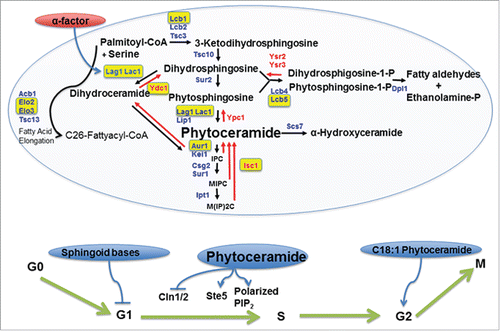Ceramide, a major bioactive sphingolipid, continues to emerge as an important regulator of many cell processes in eukaryotes such as apoptosis, inflammation, and stress responses.
In yeast, many phenotypes are attributed to deletion or mutation of one or more genes of ceramide and sphingolipid metabolism.Citation1 These include life span/aging, oxidative stress, mitochondrial function, heat resistance, drug resistance, cell cycle, nutrient response, cell wall and morphology.
The article by Villasmil et al in issue 15(3) of Cell Cycle, establishes the importance of ceramide as a regulator of the mating-specific cell cycle arrest.
Mutations or deletions in genes in the sphingolipid pathway have been already implicated in regulation of mating factor biology. For example, mutation of LCB1, which encodes for a critical subunit of serine palmitoyl transferase, the first enzyme in sphingolipid biosynthesis, has been shown to block α-factor uptake (Ref. # 23 Villasmil et al.). In a genome-wide screen, ISC1, YDC1 and LCB5, have been found defective in Ca2+ uptake following exposure to mating pheromone, with a suggested role in the activation of HACS (high affinity Ca2+ influx system).Citation2 Additional genome-wide screen studies showed that deletion of any of the following sphingolipid related genes, ISC1, SKN1, ELO2, ELO3, IFA38 or FAT1 results in decreased or absent sporulation.Citation3,4
The new study shows that cells defective in ceramide formation, because of loss of the ceramide synthases Lag1 and Lac1, are sterile. Mechanistically, this was traced to a role for ceramide in regulating the cyclin dependent kinases Cln1 and Cln2 through ceramide-mediated regulation of MAP kinase-dependent transcription. Furthermore, the study implicates ceramide in PIP2 polarization and localization of Ste5 to the plasma membrane, events known to regulate mating response. Moreover, the authors showed that addition of C12 ceramide partially suppressed the mating defect of the lac1 lag1 mutant.
These findings position ceramide in a central role in the regulation of the pheromone response (). At this point, it is unclear if ceramide regulates sporulation through Ste5 or PIP2. An intriguing observation from this study is that expressing a form of the scaffold protein Ste5Q59L that is constitutively tethered to the plasma membrane-tethered, in lac1 lag1 strain, only very partially activated the MAP kinase signaling. Despite this, the authors hypothesized that the signaling defects are most likely due to loss of Ste5 association with the plasma membrane. Further work is also needed to determine the effect of pheromone on ceramide levels in the cell and the mechanisms regulating this response. Also, given the increasing recognition that ceramide is indeed a family of closely related structural molecules that are products of combinatorial biosynthesis, it becomes of great interest to determine if pheromone action regulates the formation of very specific ceramides.
Figure 1. Upper part, the Sphingolipid pathway in budding yeast Saccharomyces cerevisiae. Enzymes enclosed in yellow boxes have been shown to be involved in sporulation, pheromone response, or in cell cycle regulation. Lag1 and Lac1 are involved in α-factor response and shmoo formation according to the new study by Villasmil et al. Enzymes in blue are part of the de-novo pathway. The enzymes in red are part of the catabolic pathways. Lower part, schematic model representing sphingolipids and their influence on the cell cycle. Sphingoid bases; phytoceramides and C18:1 phytoceramide and their targets in the cell cycle.

Interestingly, sphingolipids have also been recently implicated in regulating the cell cycle block seen in a lipolysis defective tgl3tgl4 double mutant.Citation5 From this study as well as a previous study of ours, CDC55 was implicated as a critical mediator of the action of ceramide on cell cycle regulation(Ref. # 29 in Villasmil et al). Interestingly, CDC55 was initially identified by Nickles and BroachCitation6 as a critical component of the ceramide-activated phosphatase involved in mediating effects of ceramide on yeast growth.Citation7 It would be interesting to determine if this pathway is also operative in the pheromone response.
The complexity of sphingolipid metabolism also raises an important question on the potential role of, Isc1, the inositol phophosphingolipid-phospholipase which produces ceramide from hydrolysis of complex sphingolipids. Deletion of ISC1 has been found to have a severe sporulation defect.Citation3 This raises the possibility that ceramide generated from hydrolysis of complex sphingolipids (which ultimately do derive from Lag1/Lac1) may be the more proximal mediator of the cell cycle arrest. Indeed, microarray result shows that ceramide synthesized by Isc1 regulates Ste12-regulated genes (73 genes out of 428 (Hannun: unpublished data). These results together suggest that ceramide synthesized by Isc1 has a specific role in the pheromone response that is possibly downstream of Lag1/Lac1 or plays a complementary role.
In conclusion, the results of Villasmil et al. open an exciting area of research to investigate the biologic links between sphingolipids, pheromone response, sporulation and cell cycle regulation in budding yeast.
Disclosure of potential conflicts of interest
No potential conflicts of interest were disclosed.
References
- Montefusco DJ, et al. Chem Physics Lipids 2014; 177:26-40; http://dx.doi.org/10.1016/j.chemphyslip.2013.10.006
- Martin DC, et al. J Biol Chem 2011; 286:10744-54; PMID:21252230; http://dx.doi.org/10.1074/jbc.M110.177451
- Enyenihi AH, Saunders WS. Genetics 2003; 163:47-54; PMID:12586695
- Marston AL, et al. Science 2004; 303:1367-70; PMID:14752166; http://dx.doi.org/10.1126/science.1094220
- Chauhan N, et al. Proc Natl Acad Sci U SA 2015; 112:E1077-85; http://dx.doi.org/10.1073/pnas.1423175112
- Nickels JT, Broach JR. Genes Dev 1996; 10:382-94; PMID:8600023; http://dx.doi.org/10.1101/gad.10.4.382
- Fishbein JD, et al. J Biol Chem 1993; 268:9255-61; PMID:8387486
